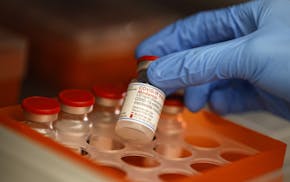KANSAS CITY, MO. - In October, a visitor delivered a small plastic bag containing several tree seeds to the Truman Library in Independence, Mo.
The seeds had fallen from trees, still standing, that survived the atomic bombing of Hiroshima in 1945. Clifton Truman Daniel, eldest grandson of former President Harry Truman, had been presented them this summer in Japan.
"The trees, like my trip, will represent reconciliation and healing," Daniel said.
Daniel, 55, became the first member of the Truman family to travel to Hiroshima and Nagasaki when he visited in August. He attended anniversary observances of the 1945 atomic bombings of both cities and met with about two dozen survivors. Daniel said he went as a private citizen to promote dialogue, he said -- not so much about the complexities of his grandfather's 1945 decision, but about new ways to promote understanding.
His efforts pleased those who believe his participation in such discussions make them more powerful. Others, while applauding his interest, wondered whether he should consider expanding the definition of "survivors" to include Americans whose lives likely were spared when the atomic bombs made a traditional invasion of Japan moot.
Some in Japan, meanwhile, wondered about the quality of Daniel's intentions. One was a Japanese TV journalist.
"The third question [out] of her mouth was 'Are you here to apologize?'" Daniel said recently from his Chicago home. "I said, 'No.' The next question was 'Then, what are you doing here?' I told her ... I was there in the name of reconciliation and healing.
"But at that point I began thinking that maybe this trip had not been such a good idea."
It began with a book
Daniel traces the trip's origins to the late 1990s when his son, Wesley, then in fourth grade, brought home a copy of "Sadako and the Thousand Paper Cranes." The book told of Sadako Sasaki, a Hiroshima girl who died in 1955 from leukemia attributed to radiation.
It also described the origami paper cranes she created while ill. She had hoped to fashion 1,000 cranes but died before completing that task.
"Wesley didn't initially make the connection between Sadako and his great-grandfather, and I reminded him of that," Daniel said. "I thought it important for him to know all sides of that issue."
Two years later, a Japanese journalist preparing a story on the bombings' 55th anniversaries contacted Daniel, who mentioned how his son had brought home the book about Sadako. Four years later, Daniel received a call from Masahiro Sasaki, Sadako's brother, who had seen that article.
Daniel had played no high-profile role in the debate that accompanied the 50th anniversary observances of the Hiroshima and Nagasaki bombings in 1995. Some historians had emphasized the astronomical number of deaths, both American and Japanese, expected during an invasion of the Japanese home islands.
Other historians posited that President Truman may have had other options.
The dialogue was sufficiently charged to scuttle a planned exhibit at the Smithsonian Institution in Washington on the Enola Gay, the B-29 bomber that dropped the bomb on Hiroshima.
In the Kansas City area, a group of World War II veterans formed the Harry S. Truman Appreciation Society, whose members in 1995 laid a wreath at the Truman Library grave of the former president.
Annual ceremonies followed. In 1998, Paul Tibbets, who had piloted the Enola Gay, spoke. Those ceremonies continue today, now organized by the Harry S. Truman Chapter of the Air Force Association.
"We believe in what President Truman did," said Pat Snyder of Overland Park, Kan., past chapter president. "We feel that his decision saved many lives."
Daniel doesn't dispute that. "Over the years I have shaken the hands of dozens of American ... veterans who have told me 'I wouldn't be alive if your grandfather had not dropped that bomb,'" he said.
"Yet I have also held one of Sadako's last paper cranes in my hand, as well. So I choose to honor both ... ."
The Latest | First 6 jurors in Trump's hush money trial seated, others still needed

Coal miners are getting new protections from silica dust linked to black lung disease
Biden visits his Pennsylvania hometown to call for more taxes on the rich and cast Trump as elitist

